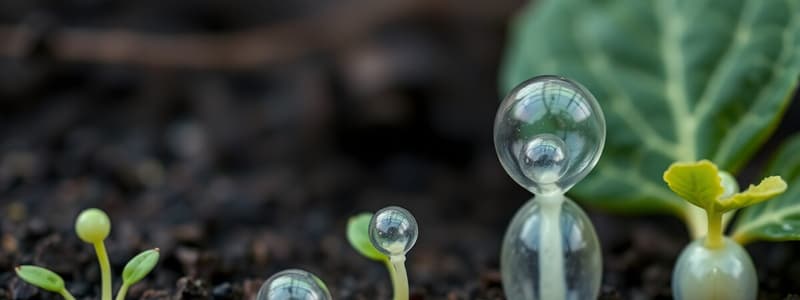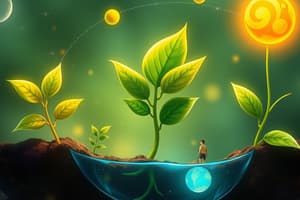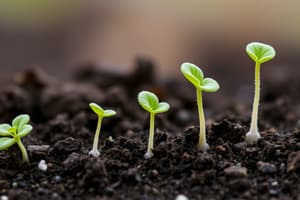Podcast
Questions and Answers
Which process leads to the death of a plant?
Which process leads to the death of a plant?
- Pollination
- Senescence (correct)
- Germination
- Photosynthesis
What characterizes annual plants?
What characterizes annual plants?
- They die in one growing season after flowering. (correct)
- They are primarily woody plants.
- They can live for an indefinite number of growing seasons.
- They have a two-year life cycle.
What is a key feature of biennial plants?
What is a key feature of biennial plants?
- They flower in the first year.
- They produce seeds immediately after germination.
- They store energy in the first year and flower in the second. (correct)
- They remain active all year long.
What occurs during the double fertilization process in angiosperms?
What occurs during the double fertilization process in angiosperms?
Which statement about perennial plants is true?
Which statement about perennial plants is true?
What describes the phenomenon where male and female structures in a flower mature at different times?
What describes the phenomenon where male and female structures in a flower mature at different times?
Which feature is typically associated with wind-pollinated angiosperms?
Which feature is typically associated with wind-pollinated angiosperms?
How do dioecious plants differ from monoecious plants?
How do dioecious plants differ from monoecious plants?
Which factor does not influence the flowering of short-day plants?
Which factor does not influence the flowering of short-day plants?
What is the primary characteristic of flowers that attract hummingbirds?
What is the primary characteristic of flowers that attract hummingbirds?
The structure made up of the combined stamens is referred to as the:
The structure made up of the combined stamens is referred to as the:
Which type of pollination occurs when pollen from one flower lands on the stigma of a different flower?
Which type of pollination occurs when pollen from one flower lands on the stigma of a different flower?
Which of the following is not a characteristic of advanced flowers?
Which of the following is not a characteristic of advanced flowers?
What term refers to the process where some flowers may aid in pollination through scent to attract specific species?
What term refers to the process where some flowers may aid in pollination through scent to attract specific species?
What type of plants are characterized by flowering irrespective of day length?
What type of plants are characterized by flowering irrespective of day length?
Flashcards are hidden until you start studying
Study Notes
Plant Life Spans
- Annual plants complete their life cycle in one growing season.
- Biennial plants live for two years, storing energy in the first year and flowering in the second.
- Perennial plants live for multiple growing seasons, producing seeds and fruits repeatedly.
- Deciduous plants lose all their leaves during a specific period of the year.
- Evergreen plants lose leaves throughout the year, never appearing bare.
- Woody plants typically live longer than herbaceous plants due to extensive secondary growth.
Germination
- Germination is the process by which a plant grows from a seed into a seedling.
- The radicle, or first root, emerges during germination.
- Environmental factors like light wavelength, temperature, and stratification (low temperature exposure) can influence germination.
Embryo Development
- Embryo development starts with fertilization of the egg cell.
- A pollen tube delivers two sperm cells to the angiosperm embryo sac.
- One sperm fertilizes the central cell, initiating endosperm development (3N).
- The other sperm fertilizes the egg, producing a zygote (2N).
- Cell division (mitosis) follows, resulting in embryo formation.
Double Fertilization
- Angiosperms undergo a unique process called double fertilization.
- A pollen grain landing on a stigma forms a pollen tube that penetrates the style.
- As the tube grows, cells divide into two sperm cells.
Diachogamy
- Separation of male and female structures in time.
- Stamens (male) and pistils (female) mature at different times in the same flower.
- Plants exhibiting diachogamy are known as dichogamous.
Promoting Outcrossing
- Separation of male and female structures in space or time to promote outcrossing.
- Dioecious plants produce either ovules (female) or pollen (male) exclusively.
- Monoecious plants have male and female flowers on the same plant that mature at different times.
Self-Pollination
- Often involves small, inconspicuous flowers that directly shed pollen onto the stigma.
- When pollinators are scarce, plants can rely on self-pollination for seed production.
- Offspring resulting from self-pollination may be more uniform and adapted to their environment.
Wind Pollination
- Some angiosperms rely on wind pollination.
- Such plants typically have:
- Small, green, odorless flowers.
- Reduced or absent corollas.
- Flowers grouped and hanging down in tassels.
Pollination
- The process of transferring pollen to the stigma.
- Self-pollination occurs when pollen from one flower pollinates the stigma of the same flower.
- Cross-pollination involves pollen from one flower pollinating the stigma of a different flower, promoting outcrossing.
- Pollination in many angiosperms depends on attracting pollinators.
Bee Pollination
- Bees are the most common insect pollinators.
- They often visit yellow or blue flowers.
- Some flowers have stripes or dots invisible to humans indicating the location of nectaries (guides for bees).
Butterfly and Moth Pollination
- Flowers visited by butterflies have flat "landing platforms".
- Flowers visited by moths are often white or pale in color and emit a strong scent.
Bird Pollination
- Flowers pollinated by birds are typically red in color and provide large amounts of nectar.
- These colors are not visible to insects.
- Hummingbirds obtain nectar from flowers that accommodate their beaks.
Other Animal Pollination
- Bats and small rodents can participate in pollination.
- Pollination signals can be species-specific.
- Monkeys are attracted to orange and yellow fruits and can disperse seeds.
Gamete Production
- Plant sexual life cycles involve an alternation of generations:
- Diploid sporophyte (2N) → haploid gametophyte (N)
- In angiosperms, the gametophyte generation is small and enclosed within the parent sporophyte's tissues.
- The male gametophyte is the pollen grain.
- The female gametophyte is the embryo sac.
Trends in Floral Evolution
-
Floral Symmetry:
- Primitive flowers are radially symmetrical.
- Advanced flowers are bilaterally symmetrical (e.g., orchids).
-
Flower Structure:
- A complete flower has four whorls:
- Calyx: Made up of sepals.
- Corolla: Composed of petals.
- Androecium: Collective term for stamens.
- Gynoecium: Collective term for carpels.
- Incomplete flowers lack one or more of these whorls.
- A complete flower has four whorls:
Light-Dependent Pathway (Photoperiodic Pathway)
- Short-day plants flower when daylight becomes shorter.
- Long-day plants flower when daylight becomes longer.
- Day-neutral plants flower regardless of day length.
- Plants flower based on day length to ensure favorable environmental conditions.
- Photoperiod manipulation in greenhouses allows for year-round flowering, such as poinsettias during winter holidays.
Studying That Suits You
Use AI to generate personalized quizzes and flashcards to suit your learning preferences.




